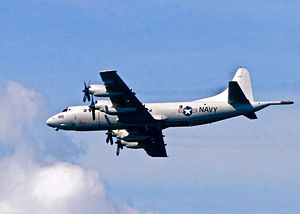Chinese fighter jets have intercepted a U.S. Navy surveillance plane, marking the second such dangerous intercept in May. The most recent event occurred on May 24, according to the Pentagon.
According to Reuters, officials speaking on condition of anonymity said that one of two Chinese J-10 fighter jets came within 180 meters of a U.S. P-3 Orion surveillance plane just 240 km southeast of Hong Kong, in international airspace. The U.S. officials told Reuters that the intercept was carried out in an “unsafe and unprofessional” manner, as the fighter jets restricted the surveillance aircraft’s ability to maneuver.
“We continue to review the facts of this incident and will convey our concerns through appropriate channels with the Chinese government,” Pentagon spokesman Navy Commander Gary Ross said in a statement.
China’s Ministry of Defense rejected the U.S. claims on Chinese social media platform Weibo, saying that the U.S. account of the intercept was inaccurate and that the fighter jets had in fact operated in a professional and safe manner.
This encounter occurred on the same day that the U.S. Navy conducted a Freedom of Navigation operation in the South China Sea, the first since October 2016. The U.S. Navy destroyer USS Dewey reportedly sailed within 12 nautical miles of Mischief Reef, where an artificial island has been constructed by China.
Earlier this month, two Chinese Su-30 fighter jets intercepted another U.S. surveillance aircraft over the East China Sea, again in international airspace. The U.S. Air Force WC-135 Constant Phoenix, a radiation-detecting aircraft, is also known as “the sniffer” and is designed to collect atmospheric samples to detect and identify any nuclear activity. It was deployed to the region as North Korea’s nuclear threats have increased in recent months.
It was reported that the two Chinese Su-30 fighter jets came within 45 meters of the WC-135, with one fighter jet inverting directly above the the U.S. aircraft. At the time, Chinese Defense Ministry officials also denied the accuracy of the American reports.
“On May 17, a U.S. surveillance plane was conducting surveillance in China’s Yellow Sea airspace. Chinese military aircraft identified and verified the US plane in accordance with law and regulations,” a Chinese Ministry of Defense spokesperson said. “Their operations were professional and safe.”
The earlier incident occurred on the same day that Beijing warned Washington not to challenge its sovereignty in the South China Sea. In an effort to shut out the U.S. from regional issues, Chinese Foreign Ministry officials said:
“At present, through the joint efforts of China and ASEAN nations, the situation in the South China Sea is stabilizing and developing in a positive direction… We hope that foreign countries will respect the efforts of China and ASEAN to jointly maintain and consolidate the current positive momentum.”
Such incidents are likely to continue and could be a sign of China’s willingness to assert its sovereignty claims over disputed areas.

































